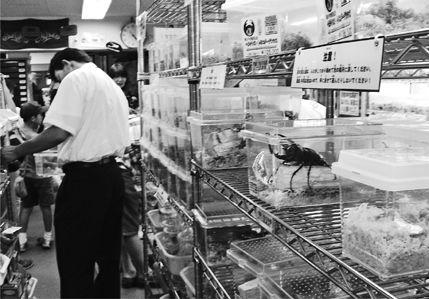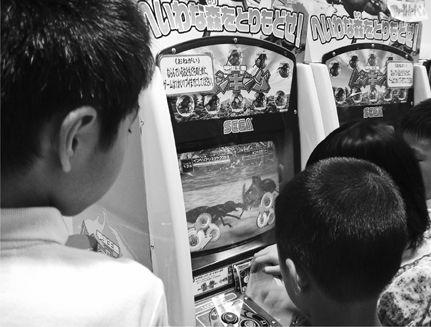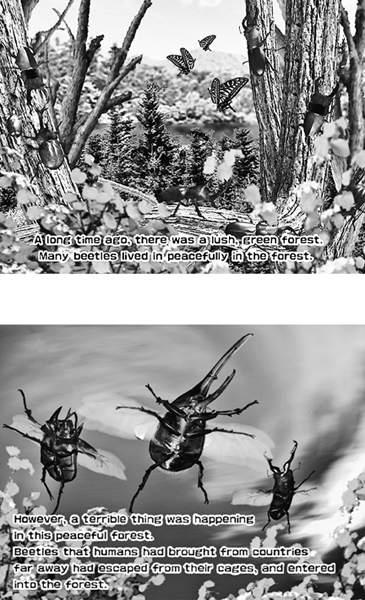Insectopedia (57 page)


Struggling to account for the surging appeal of pet insects, the author of the insect section of the Japan External Trade Organization’s
Marketing Guidebook for Major Imported Products
for 2004 pointed out that beetles “require little time and energy to take care of. They do not need to be fed anywhere in particular, and their pens take up only a small amount of space on top of a desk…. [They] do not make noise and they do not have to be taken outdoors for exercise.”
16
This seemed like an uncontroversial if superficial explanation, but the correlative claim that much of the market expansion was due to twenty-something urban women attracted to low-maintenance companion species was more dubious. Despite the apparent democratization of the hobby, despite the eager participation of some schoolgirls in summer insect projects, despite the success
of insect-loving female role models such as Miyazaki’s Princess Nausicaä, and despite Sega’s girls-only
MushiKing
events, Iijima Kazuhiko—in line with other people CJ and I spoke to—estimated that even if the total number of female insect lovers was growing, only 1 in 100 of the enthusiasts who shopped at Mushi-sha were women, a proportion that had changed little over the years. Most of the women entering the store, he said, were chaperoning their sons. Instead, insect-loving women and girls were rare enough to warrant a satirical column in
Be-kuwa!
purportedly written by a beetle-crazy dominatrix-ish
Sex and the City–
ish girl-about-town (the continuing joke being the incongruity of the glamorous Ms. Shoko’s passion for insects).
Yet there was absolutely no question that the overall base was rapidly increasing. Professional insect specialists found themselves yearning for the calm old days. The stern price discipline reputedly enforced by the
yakuza
no longer seemed so grim. Stories circulated of families, tired of pet keeping or sorry for the animal cooped up in its plastic box, driving out of town and releasing their
kuwagata
in the woods. Reports surfaced of large caches of imported beetles discovered in the countryside: surplus stock abandoned by breeders and store owners who had fallen victim to too-rapid expansion. (“It’s only the people like me, who were in this for love rather than money, who have survived,” Kuwachan told us.)
More embarrassing, a series of high-profile cases involving the arrest of Japanese nationals caught smuggling quantities of prohibited beetles out of Taiwan, Australia, and various Southeast Asian countries revealed that the incentives and possibilities for trafficking had only increased with liberalization. Similarly, surveys of Japanese insect stores found a substantial number of beetles on sale that were not only prohibited for collection in their countries of origin but also prohibited in Japan under the Plant Protection Act and, in some cases, listed under CITES, the Convention on International Trade in Endangered Species.
17
The environmental impact of the expanding Japanese market on the countries of origin was one concern for conservationists. But they also found three issues closer to home to worry about.
18
Adult stag and rhinoceros beetles are vegetarians, living on tree sap and plant juices. The larvae and imagoes are important in the early stages of forest decomposition,
mechanically breaking up decayed wood and creating the conditions for microorganisms to do their work. Beyond this, though, not much is known about their ecology. The obvious possibility was that powerful newcomers that liked similar niches would outcompete local species for food and habitat, threatening both the Japanese beetles and their food source. Goka and his colleagues were also concerned that the foreign beetles would bring unknown parasitic mites, which could undermine local beetle populations—in the same way that the varroa mite, exported from Japan with commercial hives, has devastated the European honeybee. And they worried, too, about the reduction of genetic diversity through interbreeding. Back in the lab, they created a “Frankenstein stag beetle,” successfully mating a female Sumatran
Dorcus titanus—
a popular pet—with a male from one of Japan’s twelve endemic subspecies. The sex wasn’t pretty, with the Indonesian female using what the scientists called “violent cruelty” to force herself on the reluctant Japanese male. But the resulting larvae grew into large fertile hybrids, similar to other hyphenated Japanese beetles that the scientists later collected in the wild, making real the troubling specter of genetic introgression.
19
In 2003, just as the beetle craze seemed to be cooling off, Sega launched
MushiKing.
Targeted at elementary school children, it was exciting, addictive, and elegantly simple, efficiently bringing together its audience’s passions for big beetles, obsessive collecting, competitive gaming, and souped-up graphics. Very soon it was Japan’s biggest-selling game franchise since
Pokémon
(and was doing quick business in Korea, Taiwan, Malaysia, Hong Kong, Singapore, Indonesia, Thailand, and the Philippines, too).
Sega rolled out a ruthlessly effective promotional campaign. They staged hundreds of thousands of tournaments and demonstration matches. They set up banks of console machines in department stores and hypermarkets. They flooded the country with ads. In 2005, they announced versions of
MushiKing
for Nintendo DS, Game Boy, and other handheld devices. That year Sega began a spin-off anime series on Tokyo TV. In 2006, they released the anticipated blockbuster movie.

There was no question that
MushiKing
added value to the commercialization of stag and rhinoceros beetles. Nor that in doing so it intensified
the paradoxes. Its mention provoked resigned smiles from the curator and docent in the hallway of the Itami City Insectarium, just as it did in similar conversations elsewhere. This was the summer of 2005, the height of the phenomenon, and it was obvious that the game had crystallized many insect people’s ambivalence about the form the beetle boom was taking. Keen as they were to inspire the public, happy as they were to see the excitement with which children entered their museums and stores, they had little enthusiasm for the game’s elevation of beetle belligerence and worried about the narrowing of these animals’ identities to their most mechanical aspects, worried that children would think of them as tough toys, not living creatures.
But Sega anticipated the unease. As if to mock both fears and hopes, they wrapped
MushiKing
in a package that compounded the ironies. The game wasn’t just an intensification. It was an environmental parable, and its plot was the same classic story that the insect people themselves were trying to tell.
MushiKing
described the destruction of Japan’s indigenous fauna by an invading army of fugitive imported beetles. And it enlisted Japanese children in the fight to save the nation’s endangered species. It was an apocalypse story in the tradition of the monster movies and TV shows that first made
kuwagata
and
kabutomushi
popular in the mid-1960s. It lifted its instantly recognizable plotlines from pop media, and it revealed that the scientists were drawing on those sources too. Sega and the entomologists were telling the same story. They were telling it to the same audience. And as was obvious, Sega was telling it much more seductively.

Before
MushiKing
, before the Plant Protection Act, before Mushi-sha, before inflatable
kabutomushi
in summer festivals, before insect figurines in Akihabara, before the “Befriend a Cockroach” table at the Itami City Insectarium, before Kuwachan quit his salaried job to sell
kuwagata
full-time, before Sugiura Tetsuya came home from Brazil with butterflies, before Miyazaki turned the Lady Who Loved Worms into Princess Nausicaä, before Tezuka turned Jiminy Cricket into Astro Boy, before Yoro Takeshi and his school friends hiked the mountains of Kamakura, before all of that—though after so much else—Yajima Minoru, still a
konchu-shonen
, a fourteen-year-old boy stumbling through a dark nightmare of personal and collective trauma, stood on the lip of a water-filled crater among the smoldering remains of wood-frame Tokyo—a city all but obliterated in the firestorm ordered up by Robert McNamara—and there, on the rim of the bomb crater, as all around him people scrabbled in the ruins for the remnants of their lives, he watched a dragonfly settle on a floating shard of wood and, as if nothing were any different, lay her eggs in the stagnant water. “That dragonfly didn’t care about all the corpses,” he wrote fifty years later, the image still vivid in his mind. “In the midst of that terrible reality, in spite of everything that was going on around her, she was alive and strong.”
20
Yajima-san survived the war, but only just. He writes of what he witnessed as if from a dream, a trauma-dream with all its strange infoldings of linear time. The thousands of burned and rotting corpses. The young woman alone in a charred field cradling two bundles: under one arm her colorful kimonos, under the other the blackened body of her child. Tokyo
is a “sea of fire.” Outside the factory in which he was working, he watches shrapnel explode as if in slow motion. He sees people dig useless shallow trenches in the ground for shelter, uncomprehending of the power of the B-29s. After the night of the Great Tokyo Air Raid, in which more die than even at Hiroshima, he watches the survivors gather up the piles of burned bodies. At a train station, caught in a stampeding crowd strafed by an American aircraft, a man, shot dead, falls on top of him.
Yajima-san was a sickly child. In the years leading up to the war, he came down with jaundice and spent a long time at home unable to attend school. Every day on the radio, he heard news of the successes of the Japanese military. Around him, the excitement mounted. In middle school, the students were told they were no longer children. Military exercises were compulsory. His classmates craved the honor of sacrificing themselves for the nation. His sickness, they said, was evidence of a weak mind. When he again fell ill, he was not permitted to be absent from school. As militarism increased, his health deteriorated further.
After the war, he contracted lung disease. His uncle, shell-shocked in the air raids, had moved to Saitama, in those days outside Tokyo and a place of rural calm. Here, exploring the countryside, Yajima Minoru recovered his connection to the natural world, to the dragonflies, tadpoles, ant lions, and cicadas he’d played with while in elementary school. In the fall, he helped supplement the household’s diet of poor-quality American relief bread and corned beef with locusts from the rice fields. If you observe locusts closely, he says now, you see that their eyes are really
kawaii
, and—just as cute—you see that when people approach, the animals move around to the opposite side of the rice stalk. In those days, though, it was all hunger all the time, and he thought of the insects only as food, doing his best to trap as many of them as possible.
In 1946, his doctor ordered a year of rest. Yajima moved back to Tokyo and discovered Osugi’s translation of Fabre’s
Souvenirs entomologiques.
He was fascinated by the way Fabre looked so closely at his animals and by how he reasoned from analogy. He was deeply impressed that the Insect Poet asked his questions of the living creatures he saw around him at l’Harmas; he was moved by Fabre’s curiosity and the vigor of his writing, and by the way he took you into the insects’ world, a world Yajima so badly needed at that moment.
